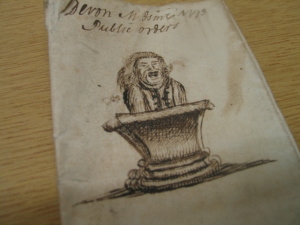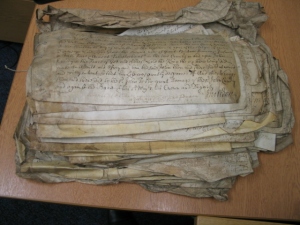Most people reading this blog will no doubt be familiar with the old adage that all good things come to an end. As summer approaches, the Quarter Sessions cataloguing project of which this blog is part and parcel is coming to a close, and your tireless qsarchivist is moving on to pastures new. So it’s a goodbye from me, and an opportunity to look back at the project and some of the things we’ve brought to light this year.
We’ve seen evidence of famines, plagues, wars and crises of all kinds for the inhabitants of Devon, examined the inner workings of eighteenth century justice and the Poor Law, borne witness to fire and flood, and puzzled over skulduggery in Aveton Giffard. There have been shipwrecks, mishaps, implausible excuses for failing to attend court, petitions from prisoners starving in the gaols, and some truly lamentable examples of sentencing excesses by the justices. The Quarter Sessions are akin to the society they reflect; colourful, expressive, lucid, and full of variety and contradiction in equal measure, and it’s been my pleasure to open the eighteenth century world they document up to examination by readers of this blog and those using the catalogue at Devon Heritage Services.
I’d like to thank readers of this blog for their contributions this year and for joining me on a fascinating journey into the past. If I were to bring all the strands of thought in this blog into a final thread as the project closes, it would be through returning to a theme I’ve spoken of through the year, a thought and motivation that has underpinned much of my enthusiasm for this project and which is one of my many motivations as a professional archivist. This theme is that of wishing to inspire in others a sympathy for and love of the past.
The documents we’ve been exploring this year convey real, not imaginary, events, and though the persons caught up in them are removed from us by a gulf of time, they were no less real, for all that, than the people around you today. Their hopes, dreams and ambitions, their passions, grievances, tragedies, trials and tribulations were as human and complex as any today, and played out across the backdrop of a world that was no less real or wonderful and frequently as cruel as our own can be today. These actors on a stage set against a vast and oft-forgotten backdrop of a former world, are our relatives, our forebears, separated from us in time but linked to us inextricably in language, custom, geography and our common humanity.
Just as I would hope that our descendants, living in an age with greater knowledge and the benefit of hindsight, will not assess our era too harshly from their point of vantage, I’ve always felt that we should be sparing in our judgments of those who went before us. They are, after all, our kith and kin, who shaped the world around us before our time. For a brief moment in time, we now occupy the places formerly held by them, and after us others will follow. What will those who follow make of our era? To care about and be inspired by the past, then, is to care about people, to be inspired by others and to be willing to learn from those who came before us.
I hope that this blog has helped to bring this past world to life, and has brought you all closer to the people who lived in it. If I have managed to achieve this in my writing, then I’ve succeeded in what I set out to do when I began writing many months ago.
Thanks once again for reading and taking part this year, and all the best!
Qsarchivist.

